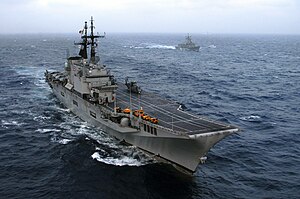Giuseppe Garibaldi (tàu sân bay Ý)
 Giuseppe Garibaldi in 2004
| |
| Lịch sử | |
|---|---|
| Tên gọi | Giuseppe Garibaldi |
| Đặt tên theo | Giuseppe Garibaldi |
| Xưởng đóng tàu | Fincantieri Monfalcone (Gorizia) |
| Đặt lườn | ngày 26 tháng 3 năm 1981[1] |
| Hạ thủy | ngày 11 tháng 6 năm 1983 |
| Nhập biên chế | ngày 30 tháng 9 năm 1985 |
| Cảng nhà | Taranto |
| Số tàu | Pennant number: 551 |
| Khẩu hiệu | Obbedisco |
| Tình trạng | Đang hoạt động |
| Ghi chú | Cost: Lire 500 billion (1991) |
| Đặc điểm khái quát | |
| Kiểu tàu | ASW aircraft carrier |
| Trọng tải choán nước | |
| Chiều dài | 180,2 m (591 ft) |
| Sườn ngang | 33,4 m (110 ft) |
| Mớn nước | 8,2 m (27 ft) |
| Động cơ đẩy |
|
| Tốc độ | 30 kn (56 km/h; 35 mph)+ |
| Tầm xa | 7.000 nmi (13.000 km; 8.100 mi) at 20 kn (37 km/h; 23 mph) |
| Thủy thủ đoàn tối đa |
|
| Hệ thống cảm biến và xử lý |
|
| Tác chiến điện tử và nghi trang |
|
| Vũ khí |
|
| Máy bay mang theo |
|
| Ghi chú | flight deck is length 174,0 m (570,9 ft) and 30,0 m (98,4 ft) wide |
Giuseppe Garibaldi là một hàng không mẫu hạm của Ý, the first through deck aviation ship ever built for the Italian Navy, and the first Italian ship built to operate fixed-wing aircraft. She is equipped with short take-off and vertical landing aircraft (STOVL) aircraft and helicopters. Giuseppe Garibaldi was involved in combat air operations off Somalia, Kosovo, Afghanistan and Libya.
Thiết kế
[sửa | sửa mã nguồn]The Giuseppe Garibaldi is the fourth ship of the Italian Navy to be named after the 19th century Italian General Giuseppe Garibaldi. All four ships, including the missile cruiser, together with an image of Garibaldi, are depicted in the crest.

Built by Fincantieri (Italcantieri) at the Monfalcone shipyards on the Gulf of Trieste, she was laid down on ngày 26 tháng 3 năm 1981,[1] launched on ngày 11 tháng 6 năm 1983, and commissioned on ngày 30 tháng 9 năm 1985. Garibaldi is classed as an anti-submarine warfare carrier (ASW), and is based in Taranto.
The ship is powered by four Fiat COGAG gas turbines built under license from GE, offering a sustained power of 81,000 hp (60 MW). Driving two shafts the ship has a maximum speed of 30 hải lý trên giờ (56 km/h; 35 mph) and can travel for 7.000 hải lý (13.000 km; 8.100 mi) at around 20 hải lý trên giờ (37 km/h; 23 mph).
The ship was equipped with four Otomat Mk2 long range surface-to-surface missile system installed at the stern of the ship (removed in 2003 to improve the flight deck and satellite communications) and two ILAS three triple tube torpedo launchers. Defences are provided by two eight-cell SAM launchers firing the SARH Aspide missile, and three Oto Melara Twin 40L70 DARDO CIWS.
The ship also has many countermeasures including two SCLAR twenty-barrel launchers for chaff, decoy, flares, or jammers, the SLQ-25 Nixie and SLAT anti-torpedo systems and ECM systems.
The air arm consists of a maximum of sixteen AV-8B Harrier IIs and two search and rescue helicopters, or eighteen Agusta helicopters or a mix of helicopters and fighters. The flight deck is the characteristic off-axis design with a 6.5 degree ski-jump for STOL aircraft; it is 174 m (571 ft) long and 30,4 m (100 ft) wide.[3]
A 1937 law gave control of all national fixed-wing air assets to the Italian Air Force and the navy was only permitted to operate helicopters. At the time of the ship's commissioning the Garibaldi the Italian Navy Aviation did not receive her Harriers so she was reclassified as an Incrociatore portaeromobili (Italian for Aircraft carrying cruiser). Until 1988 only Italian helicopters landed on her deck, as well as Royal Navy Sea Harriers during NATO joint maneuvers. The ban on fixed-wing aircraft was lifted in 1989, and the Italian Navy acquired Harrier II fighters to fly from the Giuseppe Garibaldi.[4]

In 2009 Giuseppe Garibaldi was replaced as the flagship of the Italian navy by the new and larger carrier Cavour.
The ship underwent a modernization in 2003 and a major restructuring in 2013.
Combat operations
[sửa | sửa mã nguồn]
In 1999 with the Kosovo War in the Balkans, Italy committed Harrier AV-8B II+ fighters embarked aboard Giuseppe Garibaldi, from 13 May to early June 1999. The planes carried out 30 sorties in 63 hours of flight. The planes used Mk 82 GBU-16 bombs and AGM-65 Maverick missiles. The Italian naval force in addition to the aircraft carrier Giuseppe Garibaldi, with its air group, included the frigate lớp Maestrale Zeffiro.
Following the attacks of ngày 11 tháng 9 năm 2001 and the war on terror declared by U.S. President Bush, Italy participated in Operation Enduring Freedom in Afghanistan. Giuseppe Garibaldi was engaged as the command ship of GRUPNAVIT I, 1 Italian Shipping Group, which also included Zeffiro, the patrol team and the airman supplier in Etna. The group set sail from Taranto on ngày 18 tháng 11 năm 2001. They trained in the Indian Ocean from ngày 3 tháng 12 năm 2001 to ngày 1 tháng 3 năm 2002 and returned to Taranto ngày 18 tháng 3 năm 2002. During the mission, the AV-8B Harrier unit carried out 288 missions for a total of 860 hours of flight. Tasks carried out included interception/interdiction, sea and air support, and aircraft interdiction in Afghanistan.

Participating in the 2011 military intervention in Libya after the transfer of authority to NATO and the decision to participate in strike air-ground operations, the Italian government assigned under NATO command four Italian Navy AV-8B plus (from Garibaldi) in addition to Italian air force aircraft.[5] As of 24 March, the Italian Navy was engaged in Operation Unified Protector with the light aircraft carrier Garibaldi, the Maestrale-class frigate Libeccio and the auxiliary ship Etna.[6] Additionally the frigate lớp Orizzonte Andrea Doria and Maestrale-class frigate Euro were patrolling off the Sicilian coast in an air-defence role.[7][8] In total, until the end of the mission in Libya, the eight Italian Navy AV-8Bs flying from the carrier Giuseppe Garibaldi dropped 160 guided bombs during 1221 flight hours.[9]
Xem thêm
[sửa | sửa mã nguồn]- Italian Navy Aviation
- Italian aircraft carrier Cavour
- Italian aircraft carrier Trieste (planned)
- List of naval ship classes in service
Tham khảo
[sửa | sửa mã nguồn]- ^ a b Gardiner, Robert (1983). Conway's All the World's Fighting Ships 1947–1982, Part One: The Western Powers. Annapolis, Maryland: Naval Institute Press. tr. 66. ISBN 0-87021-918-9.
- ^ “Giuseppe Garibaldi Portaeromobili”. GlobalSecurity. Truy cập ngày 1 tháng 1 năm 2015.
- ^ Giuseppe Garibaldi – light aircraft carrier Lưu trữ 2016-12-31 tại Wayback Machine military-today.com
- ^ “Issue 11 – Harrier: The Harrier Abroad”. Aviation Classics. ngày 28 tháng 7 năm 2011. Bản gốc lưu trữ ngày 1 tháng 1 năm 2015. Truy cập ngày 1 tháng 1 năm 2015.
- ^ “contributo nazionale operazione "Odissey Dawn"”. Italian Ministry of Defense. ngày 11 tháng 6 năm 2011. Bản gốc lưu trữ ngày 20 tháng 7 năm 2011.
- ^ “Operazione "Unified Protector": navi italiane partecipano all'embargo”. Italian Ministry of Defense. ngày 25 tháng 3 năm 2011.[liên kết hỏng]
- ^ “Libia: nave Andrea Doria nel canale di Sicilia con compiti di difesa aerea da attacchi missilistici” (bằng tiếng Ý). GrNet.it. ngày 19 tháng 3 năm 2011. Bản gốc lưu trữ ngày 7 tháng 12 năm 2014. Truy cập ngày 1 tháng 1 năm 2015.
- ^ Kington, Tom (ngày 14 tháng 12 năm 2011). “Italy Gives Bombing Stats for Libya Campaign”. Defense News. Bản gốc lưu trữ ngày 28 tháng 7 năm 2012. Truy cập ngày 1 tháng 1 năm 2015.
Liên kết ngoài
[sửa | sửa mã nguồn]![]() Tư liệu liên quan tới Italian aircraft carrier Giuseppe Garibaldi tại Wikimedia Commons
Tư liệu liên quan tới Italian aircraft carrier Giuseppe Garibaldi tại Wikimedia Commons
Bản mẫu:List of ships built by Fincantieri Bản mẫu:Ship classes of the Marina Militare Bản mẫu:Aircraft carrier classes in service
 GIẢM
33%
GIẢM
33%
![[Review Sách] Điều kỳ diệu của tiệm tạp hóa Namiya](https://down-tx-vn.img.susercontent.com/8fef976e7fdbed68de49b58b2421f741.webp) GIẢM
16%
GIẢM
16%
 GIẢM
22%
GIẢM
22%
 GIẢM
17%
GIẢM
17%
 GIẢM
33%
GIẢM
33%
 GIẢM
11%
GIẢM
11%



